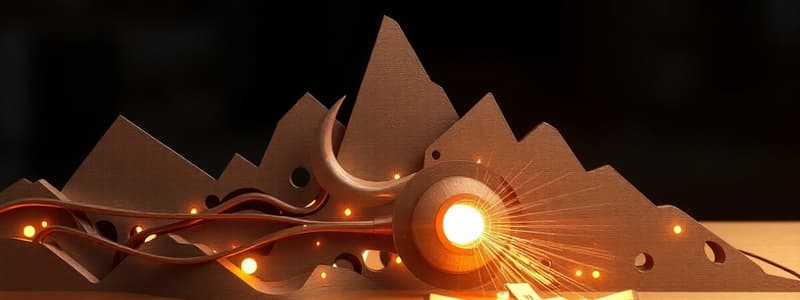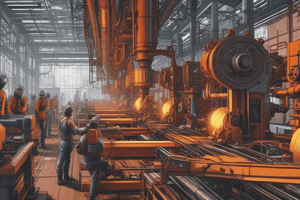Podcast
Questions and Answers
What characterizes orthogonal cutting?
What characterizes orthogonal cutting?
- The cutting tool moves parallel to the workpiece material.
- It requires the use of water to assist in cutting.
- The cutting edge of the tool is perpendicular to the direction of tool travel. (correct)
- The cutting tool is at an oblique angle to the workpiece.
Which type of cutting tool has a longer cutting life?
Which type of cutting tool has a longer cutting life?
- Waterjet cutting tool
- Oblique cutting tool (correct)
- Orthogonal cutting tool
- Plasma cutting tool
What is a primary motion in metal cutting?
What is a primary motion in metal cutting?
- The axial movement of the workpiece.
- The feed motion of the cutting tool.
- The rotation of a workpiece in a lathe. (correct)
- The rotation of the tool around the workpiece.
Which cutting method utilizes highly pressurized water?
Which cutting method utilizes highly pressurized water?
What is a characteristic feature of oblique cutting?
What is a characteristic feature of oblique cutting?
Which of the following statements about maintained cutting tool geometry is true?
Which of the following statements about maintained cutting tool geometry is true?
What is the primary purpose of cutting fluids?
What is the primary purpose of cutting fluids?
Plasma cutting is characterized by which of the following?
Plasma cutting is characterized by which of the following?
Which type of cutting tool is classified as having a single cutting edge?
Which type of cutting tool is classified as having a single cutting edge?
What is the primary purpose of the rake angle in cutting tools?
What is the primary purpose of the rake angle in cutting tools?
What effect does a positive rake angle have on the cutting process?
What effect does a positive rake angle have on the cutting process?
What is the primary function of the clearance angle in a cutting tool?
What is the primary function of the clearance angle in a cutting tool?
Which of the following describes a negative rake angle?
Which of the following describes a negative rake angle?
What type of cutting tool includes items such as hobs and gear shaping cutters?
What type of cutting tool includes items such as hobs and gear shaping cutters?
Which characteristic is NOT associated with rake angles?
Which characteristic is NOT associated with rake angles?
Which statement about clearance angles is accurate?
Which statement about clearance angles is accurate?
What is the Back Clearance Angle (αY)?
What is the Back Clearance Angle (αY)?
In the ASA system, the Nose Radius (r) is represented in which unit?
In the ASA system, the Nose Radius (r) is represented in which unit?
Which angle cannot be zero or negative in the ASA system?
Which angle cannot be zero or negative in the ASA system?
What does the approach angle (Φs) represent?
What does the approach angle (Φs) represent?
Which system measures the Nose Radius in millimeters?
Which system measures the Nose Radius in millimeters?
How many features are specified in the tool nomenclature according to the ASA system?
How many features are specified in the tool nomenclature according to the ASA system?
The Side Rake Angle (γX) can have which of the following values in the ASA system?
The Side Rake Angle (γX) can have which of the following values in the ASA system?
In a tool nomenclature specified as –8º, 6º, 5º, 10º, 15º, 30º, 1/8 (inch), what does the value –8º represent?
In a tool nomenclature specified as –8º, 6º, 5º, 10º, 15º, 30º, 1/8 (inch), what does the value –8º represent?
What is the primary function of the Reference Plane (πR) in the ASA system?
What is the primary function of the Reference Plane (πR) in the ASA system?
Which of the following angles is measured on the Machine Transverse Plane (πY)?
Which of the following angles is measured on the Machine Transverse Plane (πY)?
How many rake angles are specified in the tool signature of the ASA system?
How many rake angles are specified in the tool signature of the ASA system?
What does the Side Clearance Angle (αX) measure?
What does the Side Clearance Angle (αX) measure?
What is the sequence followed when writing the tool signature in the ASA system?
What is the sequence followed when writing the tool signature in the ASA system?
Which planes are used as reference in the ASA system?
Which planes are used as reference in the ASA system?
What is indicated by the Nose Radius in the ASA tool signature?
What is indicated by the Nose Radius in the ASA tool signature?
What does the term 'Machine Longitudinal Plane (πX)' denote in the ASA system?
What does the term 'Machine Longitudinal Plane (πX)' denote in the ASA system?
What is the primary disadvantage of using mineral oils in machining operations?
What is the primary disadvantage of using mineral oils in machining operations?
Which property is commonly associated with synthetic liquids?
Which property is commonly associated with synthetic liquids?
What percentage of mineral oil is typically found in semi-synthetic fluids?
What percentage of mineral oil is typically found in semi-synthetic fluids?
What is an example of a solid lubricant?
What is an example of a solid lubricant?
What are cutting oils primarily composed of?
What are cutting oils primarily composed of?
What is the main function of the headstock in a lathe machine?
What is the main function of the headstock in a lathe machine?
In what operations are semi-synthetic fluids primarily utilized?
In what operations are semi-synthetic fluids primarily utilized?
What component connects the headstock and the tailstock in a lathe machine?
What component connects the headstock and the tailstock in a lathe machine?
Flashcards are hidden until you start studying
Study Notes
Metal Cutting Mechanism
- Metal cutting involves using a wedge-shaped tool to remove material from a workpiece in the form of a chip.
- Two motions are involved: primary (workpiece rotation) and secondary (tool feed).
- Orthogonal cutting: cutting face perpendicular to tool travel direction.
- Oblique cutting: cutting edge inclined at an angle less than 90 degrees to tool travel direction.
Types of Metal Cutting
- Orthogonal cutting: Cutting tool moves directly into the workpiece at a right angle.
- Oblique cutting: Cutting tool engages with the workpiece material at an angle other than 90 degrees.
- Waterjet cutting: Uses high-pressure water for metal particle erosion.
- Plasma cutting: Uses an electric arc through gas to cut metal.
- Laser cutting: Uses focused laser beams to melt and vaporize metal.
- Flame cutting: Uses an oxy-fuel torch to heat and cut metal.
- Metal turning: Removes material from a rotating workpiece using a single-point cutting tool.
Tool Geometry
- Rake angle (γ): Angle of inclination of rake surface from reference plane.
- Clearance angle (α): Angle of inclination of clearance surface from the finished surface.
- Rake angle can be positive, negative, or zero.
- Positive rake: Reduces cutting force and power requirement.
- Negative rake: Increases edge strength and tool life.
- Zero rake: Simplifies tool design and manufacture.
- Clearance angle: Prevents rubbing between the tool and the machined surface, reducing energy loss and damage.
Tool Signature in ASA System
- Reference Plane (πR): Perpendicular to the cutting velocity vector.
- Machine Longitudinal Plane (πX): Perpendicular to the reference plane, along the longitudinal feed direction.
- Machine Transverse Plane (πY): Perpendicular to the reference plane, along the transverse feed direction.
Tool Signature in ORS System
- Similar to ASA system, but uses Cutting plane, Orthogonal plane, and Reference plane for reference.
- Side Rake Angle (γX): Angle of rake surface measured in the machine longitudinal plane.
- Back Rake Angle (γY): Angle of rake surface measured in the machine transverse plane.
- Side Clearance Angle (αX): Angle of principal flank surface measured in the machine longitudinal plane.
- Back Clearance Angle (αY): Angle of principal flank surface measured in the machine transverse plane.
- Approach Angle (Φs): Angle between principal cutting edge and the machine transverse plane.
- End Cutting Edge Angle (Φe): Angle between auxiliary cutting edge and the machine longitudinal plane.
- Nose Radius (r): Curvature at the tool tip (measured in inches in ASA, millimeters in ORS).
Cutting Fluids
- Mineral Oil: Good lubricating properties, suitable for high production machines and heavy cutting operations.
- Synthetic Liquids: Water-based, good cooling properties but not ideal lubricants, can cause corrosion.
- Semi-Synthetic Fluids: Combination of synthetic fluid and soluble oils, provides both cooling and lubricating properties.
- Solid and Paste Lubricants: Applied directly to the workpiece or tool, examples include molybdenum disulfide, graphite, wax stick.
- Cutting Oil: Mixture of mineral oils and fatty oils, provides both cooling and lubricating properties.
Studying That Suits You
Use AI to generate personalized quizzes and flashcards to suit your learning preferences.





